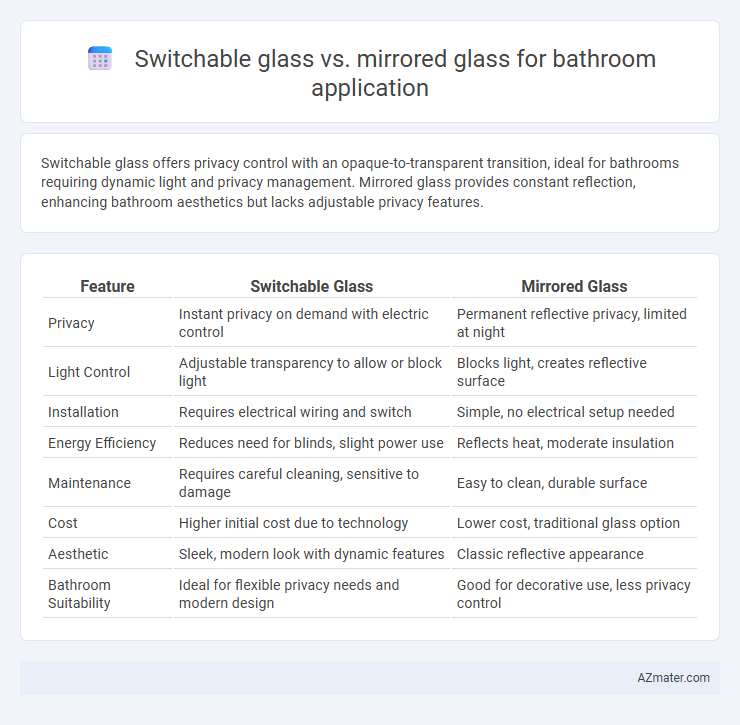Switchable glass offers privacy control with an opaque-to-transparent transition, ideal for bathrooms requiring dynamic light and privacy management. Mirrored glass provides constant reflection, enhancing bathroom aesthetics but lacks adjustable privacy features.
Table of Comparison
| Feature | Switchable Glass | Mirrored Glass |
|---|---|---|
| Privacy | Instant privacy on demand with electric control | Permanent reflective privacy, limited at night |
| Light Control | Adjustable transparency to allow or block light | Blocks light, creates reflective surface |
| Installation | Requires electrical wiring and switch | Simple, no electrical setup needed |
| Energy Efficiency | Reduces need for blinds, slight power use | Reflects heat, moderate insulation |
| Maintenance | Requires careful cleaning, sensitive to damage | Easy to clean, durable surface |
| Cost | Higher initial cost due to technology | Lower cost, traditional glass option |
| Aesthetic | Sleek, modern look with dynamic features | Classic reflective appearance |
| Bathroom Suitability | Ideal for flexible privacy needs and modern design | Good for decorative use, less privacy control |
Introduction to Bathroom Glass Solutions
Switchable glass and mirrored glass offer distinct benefits for bathroom applications, enhancing privacy and aesthetics. Switchable glass provides dynamic opacity control, allowing seamless transition between transparent and frosted states, ideal for modern, tech-savvy bathrooms. Mirrored glass delivers reflective surfaces that amplify light and spatial perception, creating a stylish and functional bathroom environment.
What is Switchable Glass?
Switchable glass, also known as smart glass, is an innovative material that changes from transparent to opaque with the application of an electric current, offering privacy on demand for bathroom settings. Unlike mirrored glass, which reflects light and offers a fixed level of privacy, switchable glass provides customizable privacy and natural light control while maintaining a modern aesthetic. It is energy-efficient, enhances user comfort, and reduces the need for additional window coverings in bathroom designs.
What is Mirrored Glass?
Mirrored glass is a type of glass coated with a reflective material, typically aluminum or silver, that creates a smooth and highly reflective surface ideal for bathroom applications. This glass enhances natural light and adds a sense of spaciousness while providing privacy by reflecting the interior environment. Unlike switchable glass, mirrored glass lacks dynamic opacity control but offers a durable and stylish solution for bathroom mirrors and decorative fixtures.
Privacy Control: Switchable vs Mirrored Glass
Switchable glass offers dynamic privacy control by instantly transitioning from transparent to opaque with a simple electrical switch, making it ideal for bathrooms where variable privacy is needed. Mirrored glass provides constant privacy by reflecting light and obscuring visibility from the outside but lacks the flexibility to adjust transparency. For bathroom applications, switchable glass enhances user convenience and privacy customization, whereas mirrored glass delivers passive privacy without user control.
Aesthetics and Design Flexibility
Switchable glass offers superior design flexibility for bathrooms by allowing users to toggle between transparent and opaque states, creating versatile privacy options without compromising natural light. Mirrored glass provides a sleek, reflective surface that enhances aesthetics by visually expanding space and adding a modern touch, but lacks the dynamic privacy control of switchable glass. Both materials contribute distinct visual impacts, with switchable glass emphasizing functionality and adaptability, while mirrored glass focuses on elegance and spatial enhancement.
Light Transmission and Illumination
Switchable glass offers dynamic control over light transmission, allowing users to adjust opacity and optimize natural illumination in bathroom spaces, enhancing privacy without compromising brightness. In contrast, mirrored glass significantly reduces light penetration by reflecting light away, often resulting in darker interiors that rely more on artificial lighting. For bathrooms aiming to balance privacy with ample natural light, switchable glass provides superior illumination management compared to mirrored glass.
Maintenance and Cleaning Requirements
Switchable glass requires minimal cleaning with non-abrasive, alcohol-free cleaners to maintain its smart film's functionality, ensuring long-term clarity and performance in bathroom environments. Mirrored glass demands frequent cleaning to prevent streaks, smudges, and water spots, especially due to moisture and condensation prevalent in bathrooms. Both types benefit from soft microfiber cloths, but switchable glass's advanced coating is more sensitive to harsh chemicals compared to traditional mirrored surfaces.
Durability and Moisture Resistance
Switchable glass offers superior durability with its robust laminate structure designed to withstand frequent usage and resist scratches, making it ideal for bathroom environments. Mirrored glass, while visually appealing, tends to be more prone to moisture damage and corrosion due to its reflective coating, compromising long-term performance in high-humidity areas. Both glass types require proper sealing, but switchable glass excels in maintaining clarity and functionality under constant moisture exposure.
Energy Efficiency and Insulation
Switchable glass offers superior energy efficiency in bathroom applications by dynamically controlling light transmission and reducing heat loss, which helps maintain consistent indoor temperatures and lowers heating costs. Mirrored glass provides limited insulation benefits as it primarily reflects light and heat but does not significantly prevent thermal transfer, often resulting in higher energy consumption. For optimal insulation and energy savings, switchable glass outperforms mirrored glass by actively managing solar gain and enhancing privacy without compromising thermal performance.
Cost Comparison and Value for Bathrooms
Switchable glass for bathroom applications typically incurs higher upfront costs than mirrored glass due to its advanced technology and electrical components. Mirrored glass offers a more budget-friendly option while providing essential reflective functionality without the need for power supply or maintenance. Investing in switchable glass adds value through privacy control and modern aesthetics but may not justify the cost for all bathroom designs compared to the cost-efficiency of mirrored glass.

Infographic: Switchable glass vs Mirrored glass for Bathroom application
 azmater.com
azmater.com